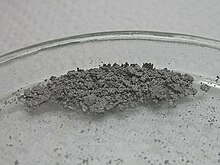
Back أسيتيليد الفضة Arabic Acetylid stříbrný Czech Silberacetylid German Acetiluro de plata Spanish Acétylure d'argent French Carburo di argento Italian Zilveracetylide Dutch Acetylenek srebra Polish Acetileto de prata Portuguese Ацетиленид серебра Russian
 | |
| Names | |
|---|---|
| Preferred IUPAC name
Silver acetylide | |
| Systematic IUPAC name
Silver(I) ethynediide | |
Other names
| |
| Identifiers | |
| |
3D model (JSmol)
|
|
| ChemSpider | |
PubChem CID
|
|
CompTox Dashboard (EPA)
|
|
| |
| |
| Properties | |
| Ag2C2 | |
| Molar mass | 239.758 g·mol−1 |
| Appearance | gray or white solid |
| Density | 4.47 g/cm3[1] |
| Melting point | 120 °C (248 °F; 393 K) |
| Boiling point | decomposes |
| insoluble | |
| Hazards | |
| Occupational safety and health (OHS/OSH): | |
Main hazards
|
highly sensitive primary explosive |
| NFPA 704 (fire diamond) | |
| Flash point | 77 °C (171 °F; 350 K) |
| Thermochemistry | |
Std enthalpy of
formation (ΔfH⦵298) |
357.6±5.0 kJ/mol[2] |
Except where otherwise noted, data are given for materials in their standard state (at 25 °C [77 °F], 100 kPa).
| |
Silver acetylide is an inorganic chemical compound with the formula Ag2C2, a metal acetylide. The compound can be regarded as a silver salt of the weak acid, acetylene. The salt's anion consists of two carbon atoms linked by a triple bond, thus, its structure is [Ag+]2[−C≡C−]. The alternate name "silver carbide" is rarely used, although the analogous calcium compound CaC2 is called calcium carbide. Silver acetylide is a primary explosive.
- ^ McCowan, J. D. (1963). "Decomposition of silver acetylide". Transactions of the Faraday Society. 59: 1860–1864. doi:10.1039/tf9635901860.
- ^ Finch, Arthur; Gardner, Peter J.; Head, Arthur J.; Majdi, Hassan S. (1991). "The standard enthalpy of formation of silver acetylide". Thermochimica Acta. 180: 325–330. Bibcode:1991TcAc..180..325F. doi:10.1016/0040-6031(91)80402-5.

